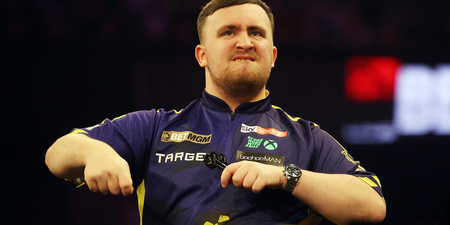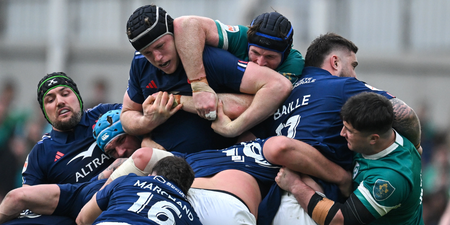Brought to you by:

Big wave surfers are a breed apart.
They live on the edge of fear, constantly chasing that next wave and knowing that a mistake could end in disaster. Every time they go out on the water, they’re taking on the elements, the weather and their own physical limits.
There’s something refreshingly unique about a person who’s willing to be smashed by 20 tonnes of water so that they can get a taste of a wave that’s as big as a house. Wrestling with your doubts is as much a part of big wave surfing as wrestling with the elements.
Irish big wave surfing veteran, Peter Conroy, is one of the pioneers of the sport in this country. He combines his day job as a firefighter with his passion for big wave surfing. Both roles can require an ability to face your fear and take controlled risks. Big wave surfing demands an ability to rebel against your instincts and to embrace the fear that comes when you’re on the cusp of a monster wave.
Clip via Peter Conroy
“A lot of my friends who were very good surfers wouldn’t go near the stuff I was surfing,” Peter explains to SportsJOE. “Big wave surfing is 80% brain and 20% ability. It’s 80% letting go of the rope and paddling into the wave. I had an ability to hold the fear in and not panic when I wiped out. It is a mental game when it comes to the big wave stuff.”
It helps that the Clare native has a background in competitive swimming and lifesaving. That skillset still stands to him, just as it did when he first took up surfing at the age of 17. What the late starter lacked in talent, he made up for with determination.
“With my swimming ability and fitness, I didn’t mind wiping out,” he explains. “And I was willing to get back out and do it again and again.”
It wasn’t until he returned from college in England that he start to really embrace surfing. He moved back to Ireland in 2004, got a job as a firefighter, bought a house near the coast and started beach surfing throughout the year.
A big wave revolution
Meanwhile, tow surfing was reinventing big wave surfing and Irish surfers started to adopt this approach to reach Irish waves that would once have been pipe dreams. Tow surfing uses jet skis to bring surfers out to bigger, faster-moving waves that couldn’t otherwise be reached by paddling.
For the first time, Irish surfers could reach waves like Aileen’s off the Cliffs of Moher and Mullaghmore, another monster wave off the coast of Sligo. Peter was instantly drawn to this new form of surfing.
“I was just OK at surfing smaller waves but I finally found my calling when big wave surfing was discovered,” he recalls. “I found myself more confident in those conditions than in smaller waves. Just point me in the direction of the wave – it was like snowboarding. And if I did wipe out, I had my swimming ability and fitness to help me.”
Clip via GOOCH APPAREL
So what’s it like when you wipe out on a big wave? Staying calm when all your instincts are screaming is key to survival.
“You have to go into your own mind and relax your body,” he says. “If you panic or your heart rate goes up, you end up using more oxygen. You have to be almost sadistic and just say that you’re going to enjoy it. You have to go to your happy place. If you start to worry, that’s where it can all go downhill.”
Peter’s worst big wave experience was at Aileen’s, a famous wave that breaks off the Cliffs of Moher. It’s an epic scene, a churning cauldron of white water and big waves that can turn ugly if things go wrong.
He recalls that it was a “massive” day, with most surfers waiting and watching rather than taking on the huge swell. Peter decided to give it a go but his first attempt went badly wrong when the wave didn’t break the way it should have.
“That left me in the impact zone. I took a 30 foot wave on the head. It wasn’t the wipeout that was the problem. I got washed in under the cliff and I was stuck there.”
He recalls feeling tiny as he looked up at his friends who were watching from above. The jet skis couldn’t get in to help. The next 40 minutes was an exhausting swim against a wall of white water to reach a point from where he could be towed to safety.
“I had to use all my swimming and lifeguard skills to get back out,” Peter recalls. “I basically had to swim out through some of the worst white water I’ve ever gone through. If I hadn’t had the swimming skills, I would 100% be dead.”
Putting safety first
It was a sobering moment but, after they got back, they decided to see what learnings they could take from it. Safety has always been at the forefront of Peter’s mind and he was one of the founders of the Irish Tow Surf Rescue Club.
The club has pioneered new safety techniques and achieved international recognition for their groundbreaking safety work. One major difference between big wave surfing and other sports is that anyone who gets badly injured has to be extracted before they can begin treating them.
Clip via Kev L Smith
The nature of the spots where they operate means that big wave surfers are inevitably their own first responders. This inspired them to establish the club so they could train themselves in rescue techniques, constantly look at ways to make the sport safer and review the way they do things to reduce risk.
“The coastguard can’t come to get us in certain spots. So the only ones who are able to help us are ourselves. When the radio says don’t go out because of the conditions, that’s when we go out.
“We’re rescue swimmers at the end of the day. We’re able to go into the water, we don’t wear lifejackets and we can carry out effective rescues. We’re basically beach lifeguards out at sea.”
Training everyone in rescue methods and life-saving techniques allowed the surfers to keep pushing the limits, confident that their friends had the skills to get them if things got hairy. Peter says that big wave surfing is actually safer than normal surfing due to the precautions that they take.
This point comes up again when we ask him to choose a favourite place to surf. It’s no surprise that Mullaghmore gets a shout out, with its left-handed break being perfect for his “goofy-footed” stance. You may be surprised at his other choice, given his chequered history with the place.
“My favourites would be Mullaghmore and Riley’s. Riley’s would be my guilty pleasure. It’s damaged me so many times!”
In case you think he’s exaggerating, the injuries he sustained surfing Riley’s include a broken back, a fractured skull, a broken nose and a chipped bone in his pelvis. Ouch. So how can it still be his favourite after inflicting so much damage on him?
“All you have to have to do is look at it. It’s beautiful!”
Clip via Freestyle Extravaganza
“Calculated crazy”
That’s what separates surfing obsessives from the average Joe on the street. It’s the hunger for the next wave and that desire to be out on the water at any cost.
Peter is quick to dismiss people who complain that big wave surfers endanger emergency services by going out in wild conditions. He points out that big wave surfers study the marine and weather charts, always assess the risks and calculate when they should and shouldn’t surf.
“If it’s too crazy, we don’t do it,” he says categorically. “We’ve gone out many times and said no, it’s too crazy. We won’t do it. We’re crazy but we’re calculated crazy!”
It still takes extreme dedication to pursue this lifestyle. Peter gets some equipment from sponsors and does safety work in exchange for gear but he still has to pay for fuel and other associated costs from his own pocket, while also working as a firefighter. There aren’t many opportunities to be a professional big wave surfer in Ireland.
“I’m only doing it for the love of it,” he says. “The fact is that people are going out with cameras or videographers now. I just want to go out there for one reason and that’s to have fun.”
He doesn’t court publicity but one of his most impressive achievements was being selected in the Billabong XXL barrel of the year top five in 2013, which happened after a photographer entered him in the competition. It’s a prestigious award and an amazing recognition for any surfer.
“Making the top five in the world for getting the biggest barrel on the Billabong XXL barrel of the year awards – that’s like going to the Oscars. It’s up there. You’re being recognised worldwide for surfing the biggest barrel – that’s like a pinnacle for me.”
He has just been nominated for the 2018 Ride of the Year for this amazing ride at Mullaghmore Head.
Clip via WSL Big Wave Awards
He admits to being tempted by famous, overseas waves like Plengkung Beach in Indonesia, Jaws in Hawaii or Mavericks in California. Yet the draw of Irish waves is stronger still.
“I say to everyone – Why go travelling around the world when we have the best waves in the world here? You could go over there and there’d be 50 people in the water whereas Mullaghmore might have only seven or eight people.”
Ireland is now being accepted as a cold weather paradise for serious waves. The closely-guarded secret that is Prowlers is just one superwave that could yet provide someone with a record-breaking ride.
The chances of seeing a surfer ride the world’s biggest-recorded wave off Ireland is now a distinct possibility. You can be certain that Ireland’s small but dedicated group of big wave surfers won’t be too far away when it happens.
Feature image by Roo McCrudden.
Brought to you by:



















































